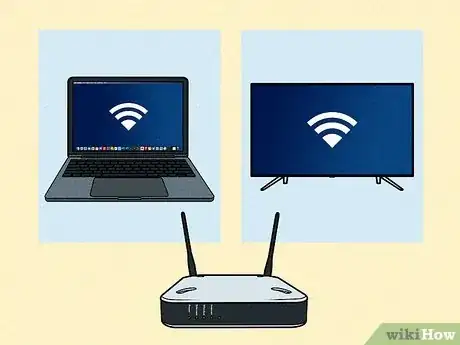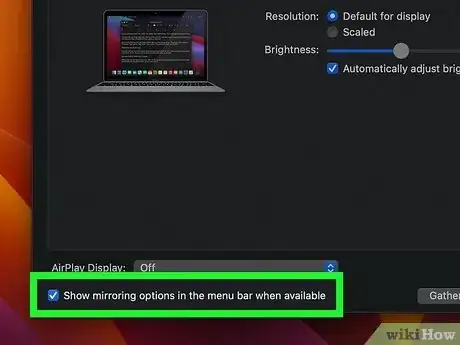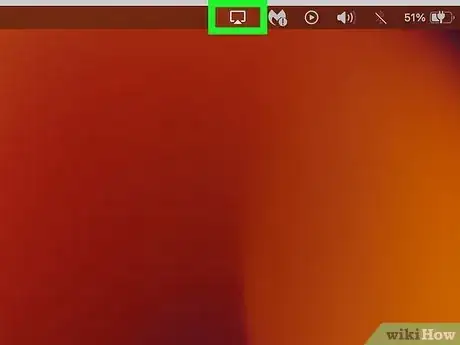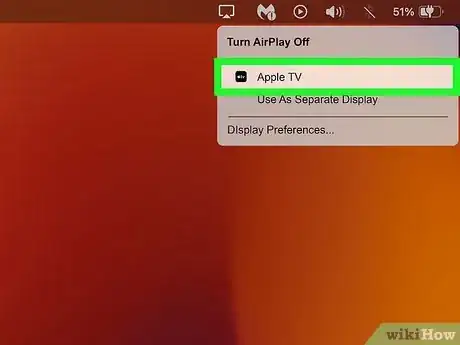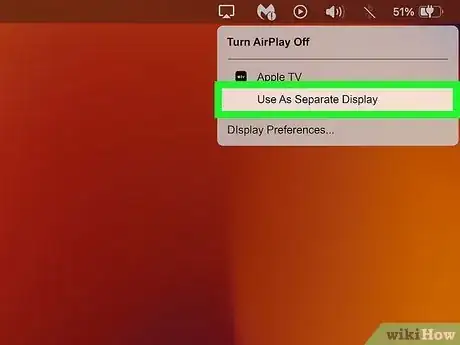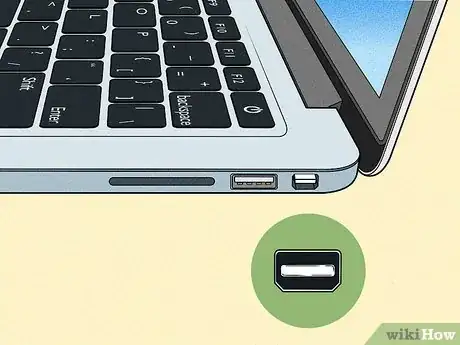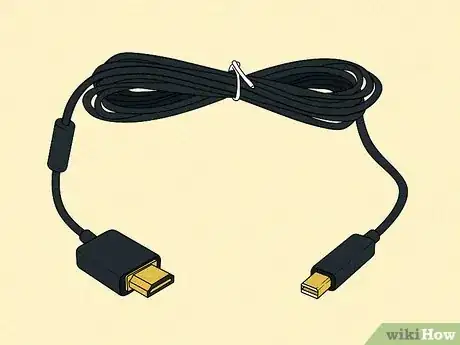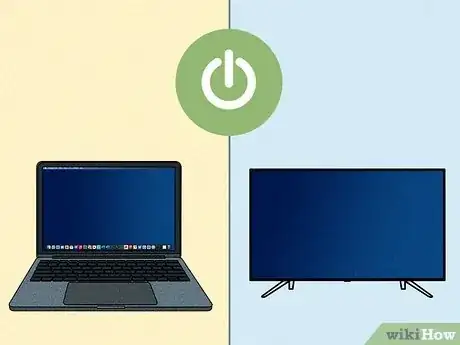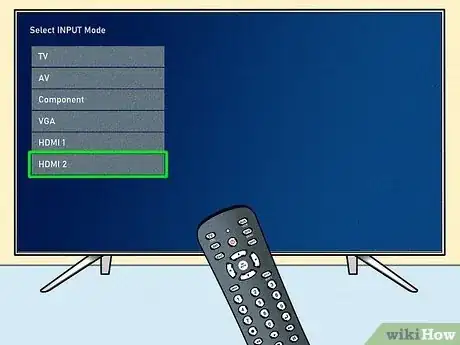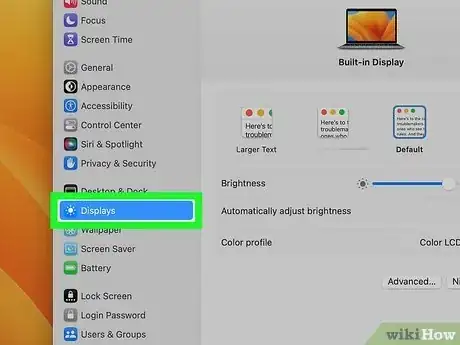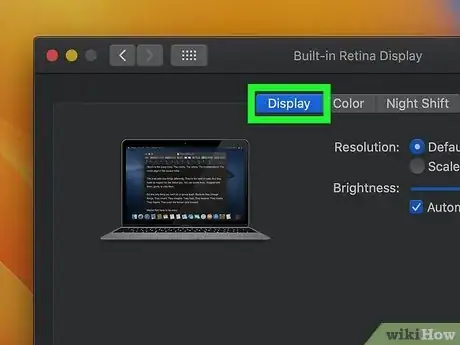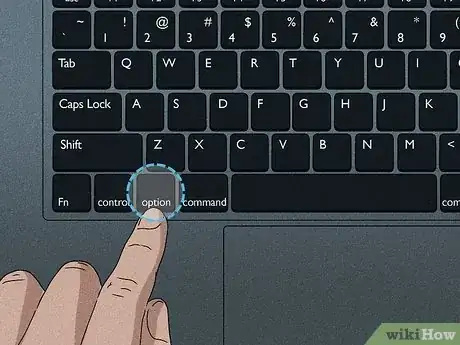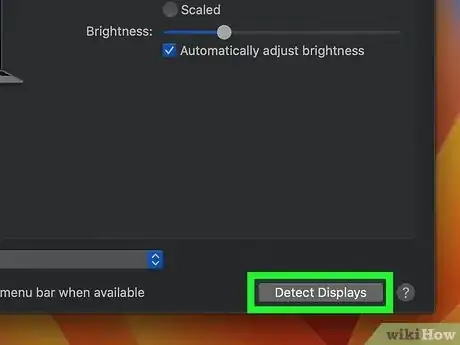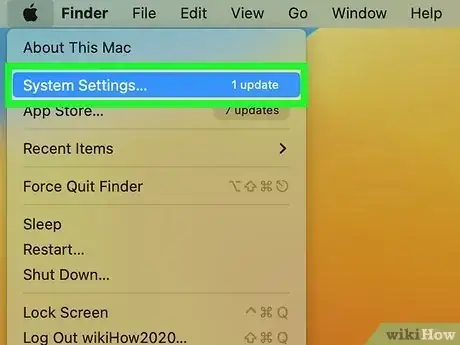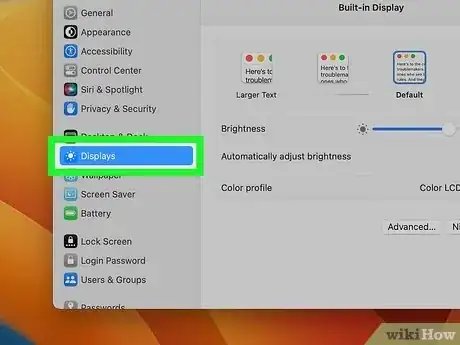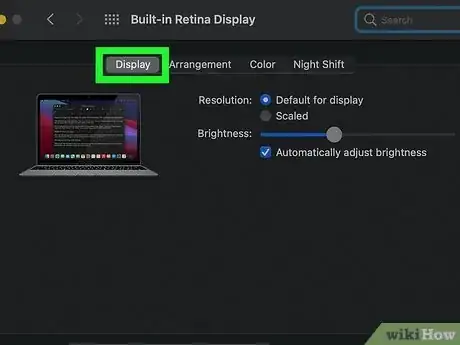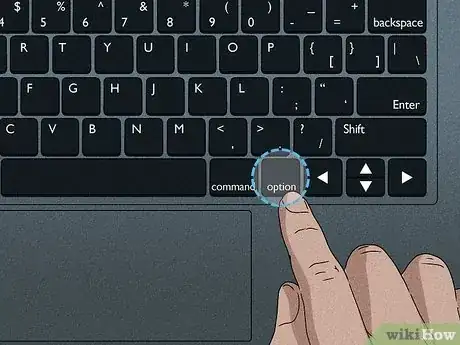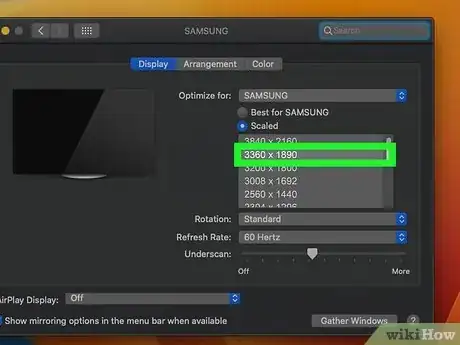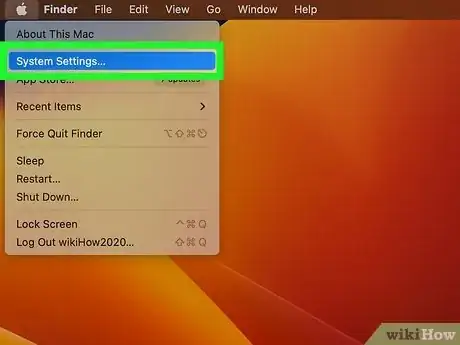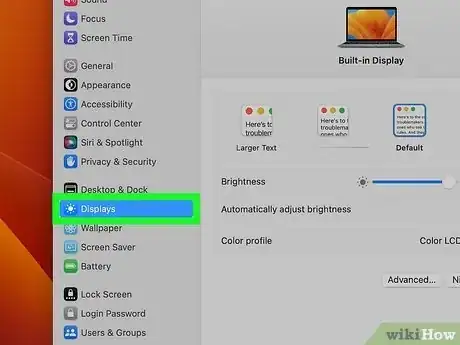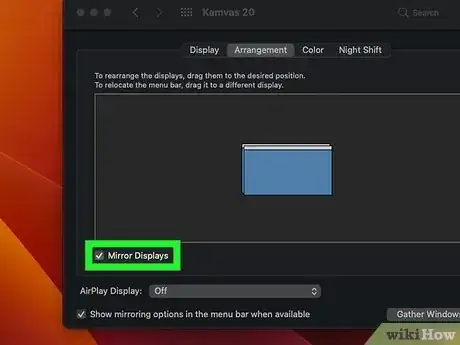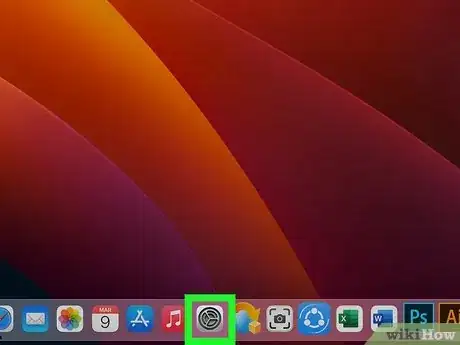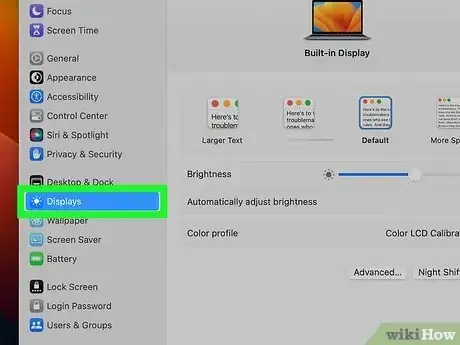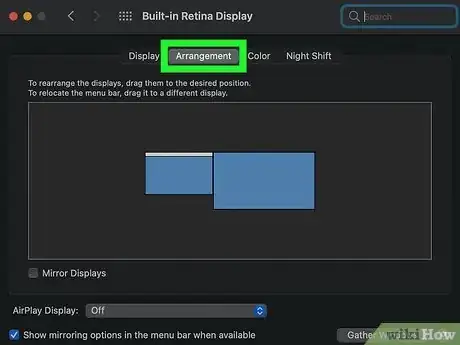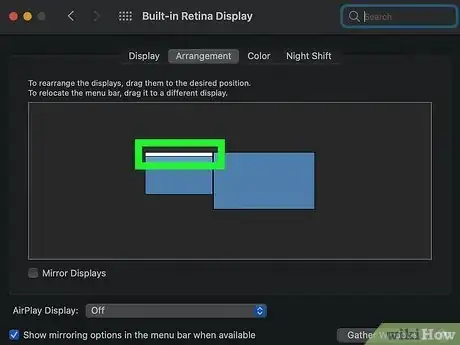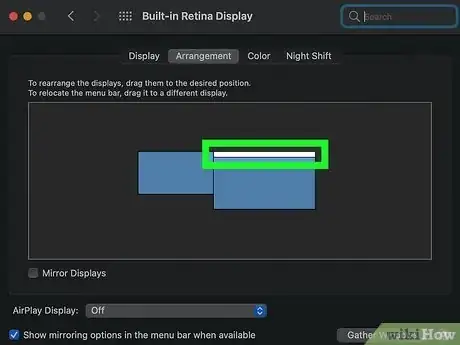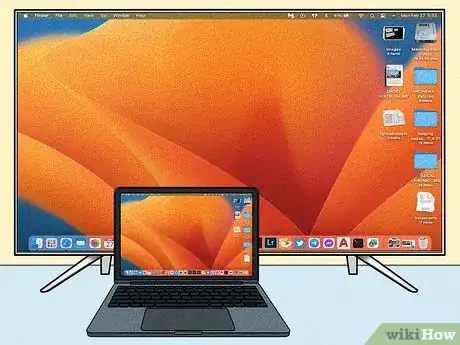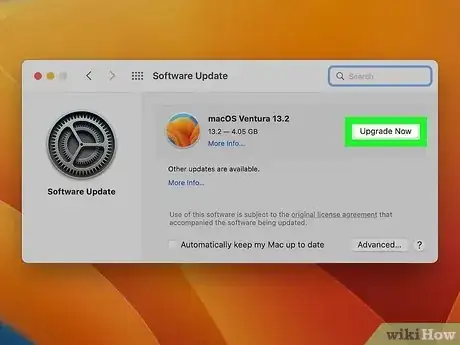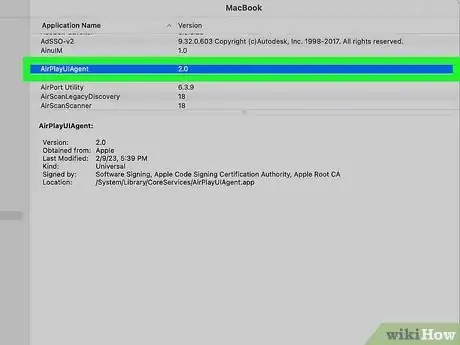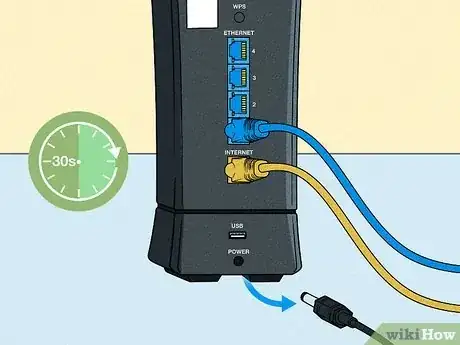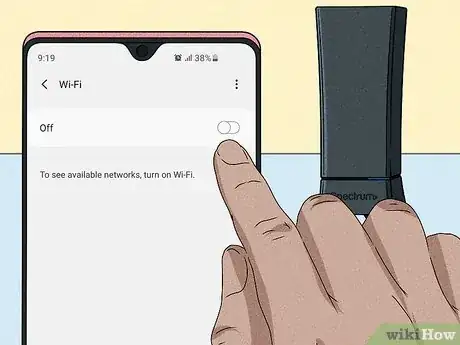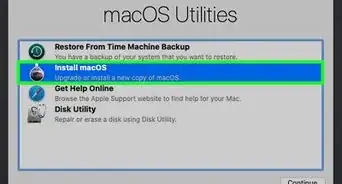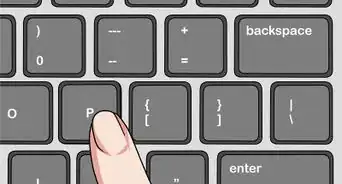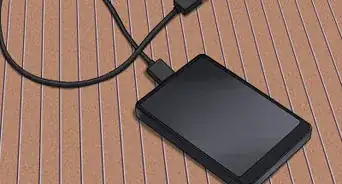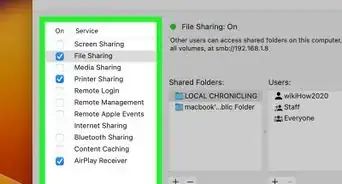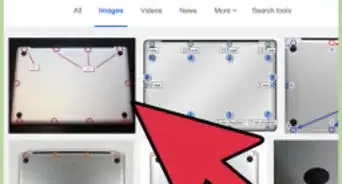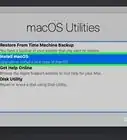Learn how to extend or mirror your MacBook Air's screen to a monitor using a cable or AirPlay
This article was co-authored by wikiHow staff writer, Kyle Smith. Kyle Smith is a wikiHow Technology Writer, learning and sharing information about the latest technology. He has presented his research at multiple engineering conferences and is the writer and editor of hundreds of online electronics repair guides. Kyle received a BS in Industrial Engineering from Cal Poly, San Luis Obispo.
There are 7 references cited in this article, which can be found at the bottom of the page.
This article has been viewed 240,401 times.
Learn more...
Do you want to use an external display with your MacBook Air? You can easily connect a monitor to your MacBook Air using a display cable. If you'd prefer to connect wirelessly, you can use AirPlay. Once you've connected the monitor to your computer, you can adjust the display settings to use it as an extended, mirrored, or primary display. This wikiHow guide will show you simple ways to connect a MacBook Air to an external monitor to extend or mirror your screen.
Things You Should Know
- Use AirPlay when you want to wirelessly connect to a wireless monitor, Apple TV, or smart TV.
- Use an HDMI or Mini DisplayPort cable to connect your MacBook Air to any monitor.
- Extend the screen to use the external display as a second monitor, or mirror the screen to see the same thing on both displays.
Steps
Using AirPlay
-
1Connect your monitor and MacBook to the same Wi-Fi network. In order to use AirPlay to connect to your monitor, both the monitor and MacBook must be connected to the same wireless network. Consult the user's manual or manufacturer's website for your monitor to learn how to connect it to a Wi-Fi network.
- Before you begin, make sure both the monitor and your MacBook are powered on.
- You can connect to any wireless monitor, Apple TV, smart TV, or streaming device that supports AirPlay 2.[1]
-
2Open your Mac's System Settings. Click the Apple menu at the top-left corner of the screen, then choose System Settings.
- If you haven't upgraded to macOS Ventura, click the Apple menu and select System Preferences instead.
Advertisement -
3Click Displays. If you're using macOS Ventura or later, you'll see this in the left menu. On earlier versions, click the monitor icon.
-
4
-
5Click the AirPlay icon in the menu bar. It's the icon that resembles a monitor with a triangle at the bottom. It's in the upper-right corner of the Menu bar. This shows available devices you can connect to with AirPlay.
-
6Click the monitor you want to connect to. This displays two display options in a pop-up window.
- Not all monitors support AirPlay. If your monitor does not support AirPlay, you can purchase an Apple TV streaming box to connect to your TV through AirPlay.
-
7Click Mirror Built-in Display or Use as Separate Display. If you want the monitor to display what is on your MacBook display, select "Mirror Built-in Display". If you want to use it as a second display, select "Use as a Separate Display". This connects your MacBook to the monitor using AirPlay.
- If needed, enter the passcode on your Mac. Some TVs and monitors may display a passcode on screen.
- To disconnect from the monitor. click the AirPlay icon in the Menu bar, then click Turn off AirPlay. [2]
Using a Display Cable
-
1Check the video out ports on your MacBook Air. In order to connect to a monitor, your MacBook needs either an HDMI port or a Mini DisplayPort. Some newer monitors use USB-C to connect to compatible USB-C ports.
- Some newer MacBook Airs do not have an HDMI port or Mini DisplayPort. If this is the case, you will need to purchase a USB-C-to-HDMI adapter to connect your MacBook Air to a monitor. Or, you can use a USB-C display.
- An HDMI cable is about 3/4 of an inch wide with the bottom slightly smaller than the top.
- A Mini DisplayPort is square-shaped with the bottom corners cut. It's the exact same shape as a Thunderbolt 1 or 2 port.
- A Thunderbolt 1 or 2 port and Mini DisplayPort have the same shaped port, but they are not the same. Check the labels on the port. A Mini DisplayPort has an icon that resembles a screen. A Thunderbolt port has an icon that resembles a lightning bolt.[3]
-
2Purchase the right cable. Once you have determined what type of video out your MacBook uses, you'll need to purchase either an HDMI cable or Mini DisplayPort cable, depending on the port on your MacBook. You may need to buy a USB-C display cable if your monitor didn't come with one.
- Make sure you get a cable that is long enough to connect your MacBook and your monitor. If need be, measure the distance between the devices.
- Mini DisplayPort cables have a Mini DisplayPort plug on one end, and an HDMI port on the other end of the cable. You can also purchase a Mini DisplayPort adapter to connect an HDMI cable directly to a Mini DisplayPort.
- If the monitor you are using does not have an HDMI or Mini DisplayPort, you can purchase an adapter from Apple or another electronics retailer. These include a MiniDisplay-to-DVI, and MiniDisplay-to-VGA adapters, as well as HDMI-to-DVI adapters.
- If you're using a MacBook with USB-C ports, you'll need a USB-C VGA Multiport Adapter for VGA displays or a USB-C Digital AV Multiport Adapter for HDMI displays.
-
3Connect one end of the cable to your MacBook. Match the shape on the end of your cable to the HDMI, Mini DisplayPort, or USB-C port on your MacBook and connect it.
- Note that connecting your MacBook to an iMac is only possible on earlier models of iMac.
-
4Connect the other end of the cable to the port on your monitor. Use the other end of the cable to connect to a free HDMI, VGA, or USB-C port on the monitor.
- If there is more than one port on your monitor, make a note of which port you are connecting to. Display ports are usually numbered.
-
5Turn on the monitor and your MacBook. Press the power button on both your MacBook and the monitor.
- If you're planning to clean your MacBook Air's screen or the external monitor's screen, keep them powered off while cleaning.
-
6Select the proper video source on the monitor. If the video has more than one video input port, press the button on the remote or monitor that says Source, Input, Video In or similar. Select the number port you connected your MacBook to. You may see your MacBook display on the monitor automatically. If it does not appear automatically, continue to the next step.
-
7Open your Mac's System Settings. Click the Apple menu at the top-left corner of the screen, then choose System Settings.
- If you haven't upgraded to macOS Ventura, click the Apple menu and select System Preferences instead.
-
8Click Displays. If you're using macOS Ventura or later, you'll see this in the left menu. On earlier versions, click the monitor icon.
-
9Click the Display tab. It's the first tab at the top of the Displays window.
- If you're using macOS Ventura, skip this step.
-
10Press and hold the Options key. This displays a button that says "Detect Displays" in the lower right corner of the Window.
-
11Click Detect Display. It's in the lower-right corner of the Display windows. Your MacBook will scan for connected displays.
Setting the Display Resolution
-
1Open your Mac's System Settings. Click the Apple menu at the top-left corner of the screen, then choose System Settings.
- If you haven't upgraded to macOS Ventura, click the Apple menu and select System Preferences instead.
-
2Click Displays. If you're using macOS Ventura or later, you'll see this in the left menu. On earlier versions, click the monitor icon.
-
3Click Display. It's the first tab at the top of the screen.
- If you're using macOS Ventura, skip this step.
-
4Press and hold Options and select "Scaled". This allows you to select a screen resolution for your monitor. By default, your MacBook will try to detect the best resolution for both your displays.[4]
- To change the resolution of your MacBook display, select "Scaled" without holding the "Options" key.
-
5Select a resolution for your monitor. A higher resolution can display smaller icons and more room on the screen. A lower resolution can display larger icons but less room on the screen. Some apps and windows may not fit on the screen with a smaller resolution.
- If it's an HD monitor, select up to 1900 x 1080. If it's a 4k or more display, select up to 3840 x 2160.
Setting Up Extended Display
-
1Open your Mac's System Settings. Click the Apple menu at the top-left corner of the screen, then choose System Settings.
- If you haven't upgraded to macOS Ventura, click the Apple menu and select System Preferences instead.
-
2Click Displays. If you're using macOS Ventura or later, you'll see this in the left menu. On earlier versions, click the monitor icon.
-
3Click on the Arrangement tab. It's the second tab at the top of the Display window.
- If you're using macOS Ventura, click the external display's name in the right menu instead.
-
4Click to uncheck the checkbox next to "Mirror Display". It's in the lower-right corner of the Display window. This allows you to use the monitor as an extended display, meaning you can move objects and apps from one display to another.
- Checking "Screen Mirroring" displays your MacBook display on the monitor exactly as it appears on your MacBook.
- In macOS Ventura and later, click Use as instead to change the mirroring setting.
Changing the Primary Display
-
1Open your Mac's System Settings. Click the Apple menu at the top-left corner of the screen, then choose System Settings.
- If you haven't upgraded to macOS Ventura, click the Apple menu and select System Preferences instead.
-
2Click Displays. If you're using macOS Ventura or later, you'll see this in the left menu. On earlier versions, click the monitor icon.
-
3Click on the Arrangement tab. It's the second tab at the top of the Display window.
- If you're using macOS Ventura, click the external display's name in the right menu instead.
-
4Click and hold the white bar at the top of the current monitor icon. There are two rectangle icons under the "Arrangement" tab in System Preferences. These represent both displays that are connected to your MacBook. The one with the white bar overhead is the current primary display.
- In macOS Ventura and later, click Use as instead to change the primary monitor. After that, you're all set!
-
5Drag the white bar to the other display icon. To change your primary display, drag the white bar at the top of one rectangular display icon to the other display icon in the Arrangements tab. Both monitors will flicker on and off for a second to adjust to the new preferences. Whichever display is set as the primary display is the default monitor that apps will launch in.
References
- ↑ https://support.apple.com/en-us/HT204289
- ↑ https://support.apple.com/en-us/HT202351
- ↑ https://support.apple.com/en-us/HT201736
- ↑ https://support.apple.com/kb/PH25175?locale=en_US
- ↑ https://support.apple.com/en-us/HT201541
- ↑ https://www.lifewire.com/airplay-icon-missing-fix-1999255
- ↑ https://www.youtube.com/watch?v=VKYxSN7t8AA
About This Article
1. Locate the HDMI or MiniDisplay port on your MacBook.
2. Connect an HDMI or MiniDisplay cable to your MacBook.
3. Connect the other end of the cable to an HDMI port on the monitor.
4. Turn on your MacBook and monitor.
5. Select the video source your MacBook is connected to on the monitor.
6. Click the Apple icon on your MacBook.
7. Click System Preferences.
8. Click the Displays icon.
9. Click the Display tab at the top of the window.
10. Press and hold the Options key.
11. Click Detect Displays in the lower-right corner of the window.
